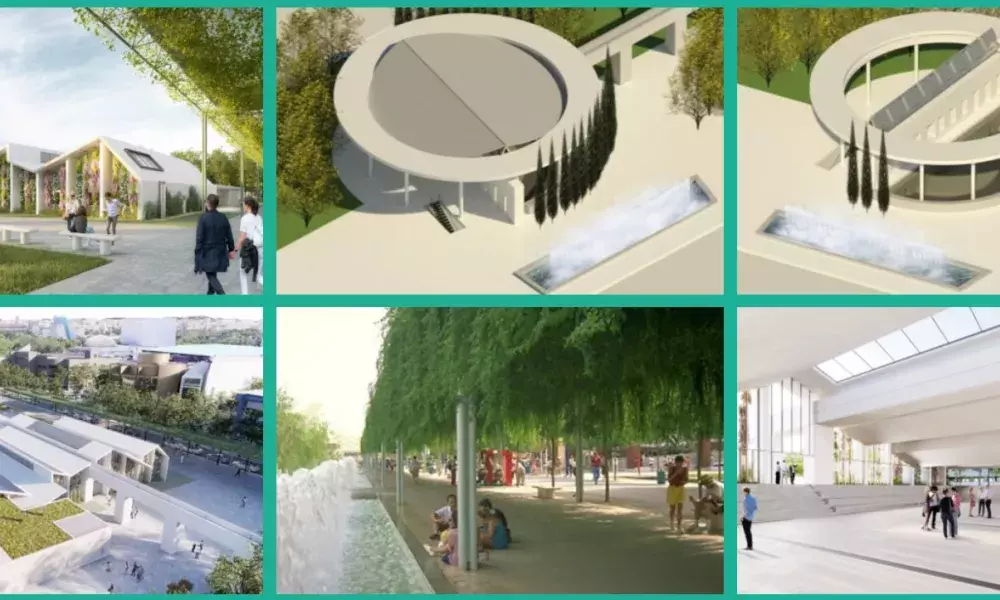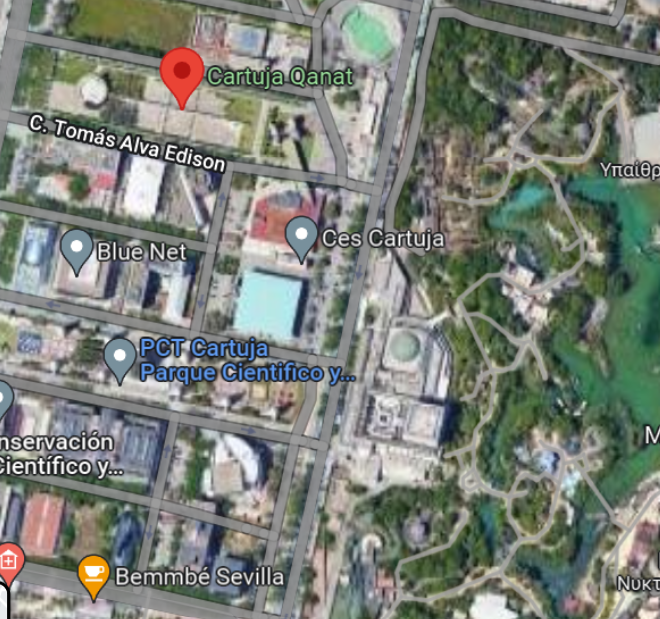Co-management and activation of large urban spaces in the era of climate transformation

Key partners involved: EMASESA, City of Sevilla, Universidad de Sevilla, PCT Cartuja
Activating a new space, dealing with multiple ownerships and maintenance. The triangle of challenges
The area of Cartuja in Sevilla, hosts a science park, parts of the University of Sevilla campus and additional compagnies hosted in the buildings of the Expo92 which took place in Sevilla. In between there are significant portions of underutilised and unmanaged public spaces, which are deserted at night despite the proximity of Cartuja to the centre. The area has, therefore, significant revitalisation potential. On the other hand, changing climate conditions mean that public life is in fact threated in Sevilla, as during the summer months temperatures are expected to reach an average of 37 degrees with extreme temperature rising to 50 degrees for more than 10 consecutive days. Lastly, due to its ‘in-between’ nature and its foreseen usage, there was no obvious accountable owner of the specific space which in practice is ‘a park within a park’.
The outbreak of the global COVID-19 campaign elevated the need for recapturing, safeguarding and revitalising public spaces in such a way as to allow liveability under diverse climatic conditions and multifunctionality. CartujaQanat is an exemplary case in this respect as it has the potential to function as a space for events organisation, academic lectures delivery and general daily recreation.
After renovating a previously semi-derelict public space, a new approach must be identified which will bring citizens closer to the space and will help meet social engagement needs. A comparative analysis between existing international practices for open space management included famous paradigms from Collective occupations in Spain to the management of Kings Cross in London, UK and led originally to the Spanish cooperative model as a potential optimal approach. A formal entity would be created in the form of a cooperative between the current key stakeholders who are linked to the space such as the Municipality of Sevilla, the University and PCT Cartuja as well as involving additional stakeholders from the organised and non-organised third sector that were to be identified.
However the above plan would be faced with a number of internal and external barriers:
- A standing prohibition to local administrations to create new entities on the basis of Spanish Law. This prohibition was put in place in the period after the 2009 EU financial crisis as a means to control the activity and expenses of the public sector. As a result, the City of Sevilla itself would in fact be excluded from the formation of a cooperative.
- The economic regulatory framework as it is currently in Spain could prevent the transfer of public sector funds to the new cooperative. Partly, this prohibition is in fact related to the absence of experience relative to such initiatives. In other words, the potential management innovation is not currently mirrored in Spanish Law and as such, according to the constitutional provisions for the operation of public entities the cooperative cannot function. A solution would be a new regulation that would specifically clarify the operational framework of public interest cooperatives.
- The outbreak of COVID19 and the global lockdowns which followed, distorted the citizen consultation process as well as the activation efforts relative to the space itself. A consultation process took place online but it was limited in terms of participation and detached from the space as there were no activities aloud.
- EMASESA and the City of Sevilla are currently working with the ‘interventor’ to identify the optimal regulatory solution to allow for the continued maintenance of the space.
- The key stakeholders of the space are EMASESA, Cartuja Science and Technology Park, the University of Sevilla and the Ayuntamiento of Sevilla (The City of Sevilla). These key entities have had divergent perceptions and interests as to the future usage of the space which, for example, referred to the possible types of uses such as event coordination, organising lectures and other student related activities or current maintenance and safety and security responsibilities.
- In addition, under the present status of the space there are several unknown factors including the future maintenance costs, the volume of activities and who will have the ultimate responsibility for any types of risks that may emerge.
Proposing an innovative governance model - process steps and timeline:
As mentioned earlier, a background comparative research was conducted on diverse public space management schemes in Spain and internationally delivered in January 2020 which informed the internal deliberations as to the optimal potential management structure for a new space.
Delivery of at least 10 online and offline stakeholder meetings and consultation processes throughout in late 2019 and throughout 2021 to map the needs that the new space could respond to including existing users of the park. Participating stakeholders involved but where not limited to businesses hosted in the Cartuja Technological Park, local civil society organisations and other potential innovators and users of the space including the broader public. In this way the new space was gradually introduced to different possible users' groups while in parallel the team captured the needs and existing gaps when it comes to potential uses.
International consultation meetings with social innovation and urban development experts
Regular meetings and negotiations between the key involved stakeholders took place regularly and with an increased intensity near the end of 2021 and early 2022.
The above two-year process, which was elongated because of the global COVID-19 pandemic interruptions led to the development of a flexible framework agreement for the co-management of the space that will span over a pilot period of four years. The agreement in its current format specifies:
the goals of the redeveloped open space as a usable area of technological demonstrations related to climate neutrality and event's and other public activities location
sets potential avenues of implementation including evaluation milestones, but doesn’t define from the outset the final operational scheme.
More importantly, the agreement describes a flexible partnership model without necessitating the formation of a new entity even if it involves the commitment of additional financial and human resources, financial revenues and actual CSO and individual citizens future involvement as co-managers of the Cartuja Qanat space.
The above two-year process, which was elongated because of the global COVID-19 pandemic interruptions led to the development of a flexible framework agreement for the co-management of the space that will span over a pilot period of four years. The agreement in its current format specifies:
More importantly, the agreement describes a flexible partnership model without necessitating the formation of a new entity even if it involves the commitment of additional financial and human resources, financial revenues and actual CSO and individual citizens future involvement as co-managers of the Cartuja Qanat space.
Key elements of the agreement and lessons learned
-
The point of view of the internal stakeholders involved is a critical element that should be considered early on as a factor when deciding to create a new space. It is a risk but also an opportunity (if managed early on) because it creates new processes for public space management
-
User Guidelines: In the case of a flexible co-management framework, it is equally important to develop commonly accept user guidelines which concern all aspects related to the management and activation of the space which is intended to be used by third parties. As such, guidelines may cover elements related to the condition of the space and may involve the signing of a flexible short-term contract; the establishment and operation of a management committee which will also be flexible as it will be allowing other individuals to be part; and rules for the insurance (there will be a general insurance covering the most basic risks)
-
Replicability of the model in other spaces in the city: The model can already be replicated in other spaces including Industrial heritage spaces and the CartujaQanat team is already working on a proposal how to manage such spaces including even the development of flexible office use (as opposed to events coordination)
-
An innovative space-management process requires flexibility, redundancy of operators and foresight for an evaluation period which should be agreed by the key parties involved.
-
The point of view of the internal stakeholders involved is a critical element that should be considered early on as a factor when deciding to create a new space. It is a risk but also an opportunity (if managed early on) because it creates new processes for public space management
-
User Guidelines: In the case of a flexible co-management framework, it is equally important to develop commonly accept user guidelines which concern all aspects related to the management and activation of the space which is intended to be used by third parties. As such, guidelines may cover elements related to the condition of the space and may involve the signing of a flexible short-term contract; the establishment and operation of a management committee which will also be flexible as it will be allowing other individuals to be part; and rules for the insurance (there will be a general insurance covering the most basic risks)
-
Replicability of the model in other spaces in the city: The model can already be replicated in other spaces including Industrial heritage spaces and the CartujaQanat team is already working on a proposal how to manage such spaces including even the development of flexible office use (as opposed to events coordination)
-
An innovative space-management process requires flexibility, redundancy of operators and foresight for an evaluation period which should be agreed by the key parties involved.
About this resource
The Urban Innovative Actions (UIA) is a European Union initiative that provided funding to urban areas across Europe to test new and unproven solutions to urban challenges. The initiative had a total ERDF budget of €372 million for 2014-2020.
Similar content





Social Innovation and the co-management of a large newly developed public space- Experimentating with new materials
- Re-inventing an ancient old water cooling technique, the Qanat which derives from the Persian empire.
- Exploring the appropriate co-management approaches to ensure the new space will be rediscovered and actively use by citizens and stakeholders alike.
- An open air amphitheatre
- A semi-underground events area
- A technology demonstration area
- Open-space recreation area

How can a city maintain its vibrant outdoors life when the temperature rises to 37 degrees on an average summer day? And how might this be possible while adhering to the Net-Zero energy consumption target set in the framework of the EU deal? This is the key strategic policy question that CartujaQanat is answering via a multitude of entry points:
The present article zooms in the third dimension: Social Innovation and the co-management of a public space.
The space: